What to do when overwhelming enemy armored forces are approaching and your only cover is peasant cottages? The Polish uhlans showed that the Soviet tanks had no chance against real fantasy, courage ... and kerosene lamps. It's time to recall the extraordinary feat of Polish cavalrymen at Kodziowce.
During the September fights, spare cavalry regiments began to form in Wołkowysk, intended to strengthen the forces of the Independent Operational Group "Narew". There were three reserve uhlan regiments:101, 102 and 110. Their full-time position left much to be desired, and the armaments were also not the best. There was a shortage of anti-tank equipment or even machine guns .
The attack carried out by the Soviets on September 17 meant that the concept of using the aforementioned regiments was changed in the Polish command. It was decided to form them (and two other improvised units) of the Reserve Cavalry Brigade of Volkovysk, whose task was to break into Lithuania.
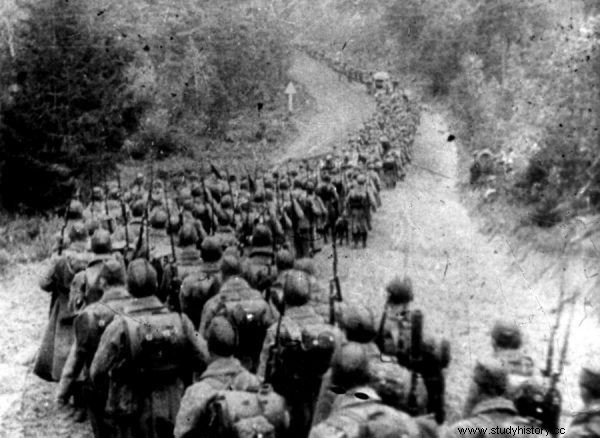
Soviet soldiers entering Poland on September 17, 1939 (photo:public domain).
First clashes with the Soviets
The newly formed brigade was directed to the Grodno region, and on the way it fought several victorious skirmishes with the Red Army units. In the city, General Wacław Przeździecki took over command of all the Polish troops gathered there. Units subordinate to him took part in the heroic defense of Grodno and then they jumped away from the enemy and headed north towards the Lithuanian border.
Late in the evening of September 21, Polish soldiers reached the area of Hoża and Sopoćkinie. The 101st lancer regiment, which was part of the Wołkowysk group, reached the village of Kodziowce, where it was supposed to settle down and wait out the night.
Where did the Soviet tanks come from?
Shortly after arriving at the parking place, the commander of the 101st Uhlan Regiment, Major Stanisław Żukowski, received a report about the approaching enemy vehicles. He briefly summarized the information: We'll manage! Where did the Soviet tanks come from ?, and then proceeded to the immediate deployment of subordinate soldiers.
Kodziowce is a small village, which in 1939 had just over 20 farms located along an unpaved road stretching from the Nemunas River to Sopoćki. There was a small hill at the western end of the village, and a strip of wet meadows adjoined the buildings to the south, so the terrain was favorable for the defense .
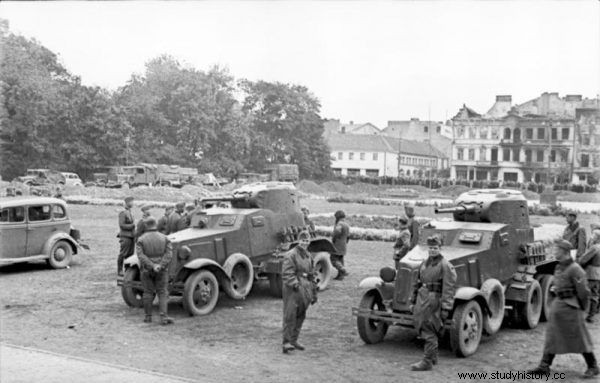
Soviet and German soldiers watch BA-10 cars. Including Polish cavalrymen near Kodziowce had to fight with such vehicles (photo:Bundesarchiv, Bild 101I-013-0068-18A / Höllenthal / CC-BY-SA 3.0).
There was also a farm on the edge of the village. It was on this basis that Major Żukowski deployed under his direct command the 3rd and 4th squadrons of the regiment, the squadron of cyclists and a half squadron of machine guns. The 1st and 2nd Uhlan squadrons, the pioneer squadron (sappers) and the rest of the machine gun squadron were placed under the command of the rtm. Narcyz Łopianowski, who was to fill the farms in the village.
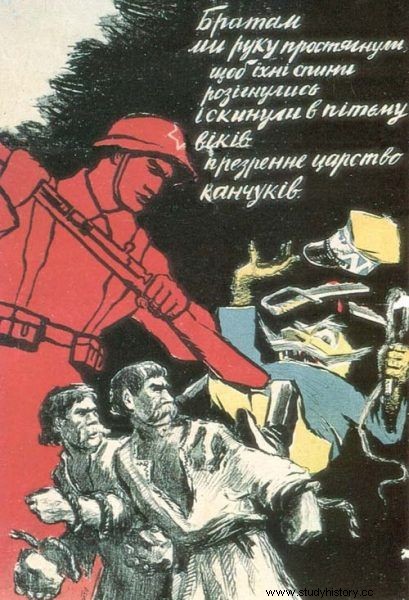
The Red Army liberates the peasants from your oppression, Soviet propaganda poster of 1939.
A unit of the Red Army, whose presence in the vicinity was reported to Maj. Żukowski, is a collective unit under the command of Maj. Chuvakin. The combat strength of the enemy far exceeded the fire capabilities of the Polish cavalry . The Krasnoarmeys had about 35 tanks (mainly BT-7s), a few BA-10 armored cars, 6 anti-tank guns and infantry-supported supply units. In total, this group consisted of almost 500 soldiers.
Careless Soviets
The evening of September 21 came. Drenched by the falling rain, the cavalry patrols watched the approaching enemy. The rest of the uhlans went to the peasant buildings to dry their uniforms and get some sleep. However, the soldiers realized that their rest at any moment could interrupt the alarm signal signifying an attack the enemy.
Around midnight, several Soviet reconnaissance vehicles drove up to the eastern buildings of the village. Prepared Poles shot at the enemy and damaged several vehicles. After a short shooting, the scout team retreated.
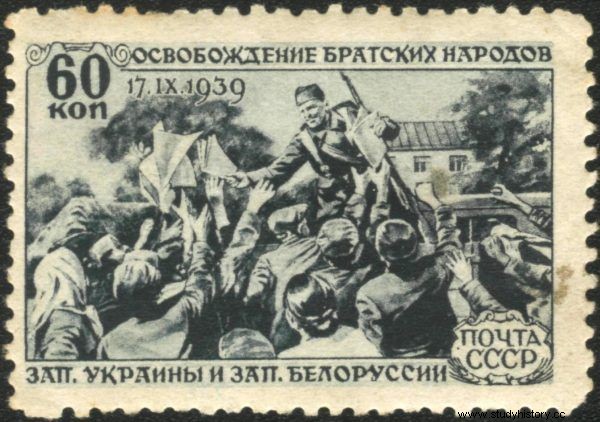
"Liberation of the fraternal nations of Western Belarus and Western Ukraine" on a Soviet postage stamp from 1940 (drawing by Ivan Dubasov, public domain).
More than an hour later, on September 22, 7 scattered BT-7 tanks broke the Polish insurance positions and drove between the buildings of the Kodziowcy, detonating anti-tank mines that had previously been set up by our pioneers. Unfortunately these charges turned out to be too weak and did not cause any damage to enemy machines . After several minutes of blind shooting, the Soviet vehicles left the village.
This article has more than one page. Please select another one below to continue reading.Attention! You are not on the first page of the article. If you want to read from the beginning click here.
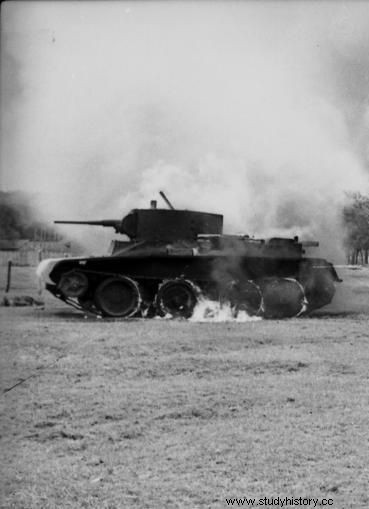
Burning BT-7 tank (photo Bundesarchiv, Bild 101I-020-1268-36 / Hähle, Johannes / CC-BY-SA 3.0).
Major Żukowski decided to act against it. The cavalry patrol sent by him discovered in the eastern outskirts of the village resting Soviet infantry that did not put up guards and was an easy target for Poles. The attack was scheduled for 4.00 am and was to be led by the regiment commander himself.
The attack of our soldiers took the enemy by surprise . Unexpectedly, at the same time, Kodziowce was attacked from the west by a tank unit supported by numerous infantry. Such a development of events meant that Major Żukowski decided to stop the successfully developing attack and return to the fortified positions at the farm.
Uhlans against tanks
The Poles did not expect a greater threat from the west. It seemed that the other regiments of General Przeździecki's group stationed on this side would not allow the Red Army to break through, so the surprise with the attack from the Sopoćki side was perfectly understandable.
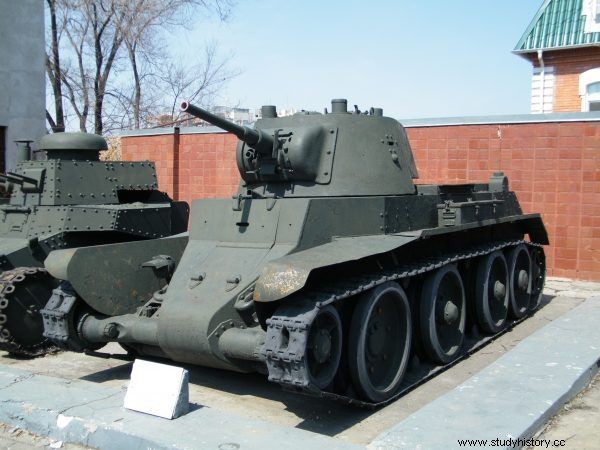
And this is what the BT-7 looked like before the Polish cavalrymen took care of them (photo:Andshel, CC BY-SA 3.0).
After a few minutes of chaotic shooting, the uhlans regrouped and began to seize the initiative. Due to the lack of anti-tank equipment, the cavalrymen attacked the tanks circulating in the countryside with bottles of gasoline. This is what captain remembers. Łopianowski:
Having experience in Grodno fighting about the effectiveness of fighting tanks with gasoline bottles, I provided my squadron with an adequate supply of these primitive weapons. These bottles were in panniers instead of underwear, and the uhlans knew how to use them.
With time, there was a shortage of bottles, and the gasoline was gradually diminishing. It was then that ingenious soldiers started taking kerosene lamps out of peasants' cottages . Then they mixed kerosene with gasoline and with such means they started to fight enemy vehicles.
The Soviets repeated their attacks as many as 11 or 12 times, but each time they were successfully repelled by our cavalrymen. The battle ended around 8 am. The Krasnarms, seeing that their losses increase with each attack, and the determination of the defenders is unwavering, decided to withdraw.
Landscape after the fight
In the morning of September 22, the eyes of the soldiers saw a gloomy sight. Among the destroyed buildings wrecks of vehicles were dying out, and there were many corpses of people and horses around . The losses on the Polish side are difficult to estimate, but they were certainly large. The commander of the regiment, Major Zhukovsky, was seriously wounded and died on the same day. It is known that the uhlans lost as much as 70% of their horses.
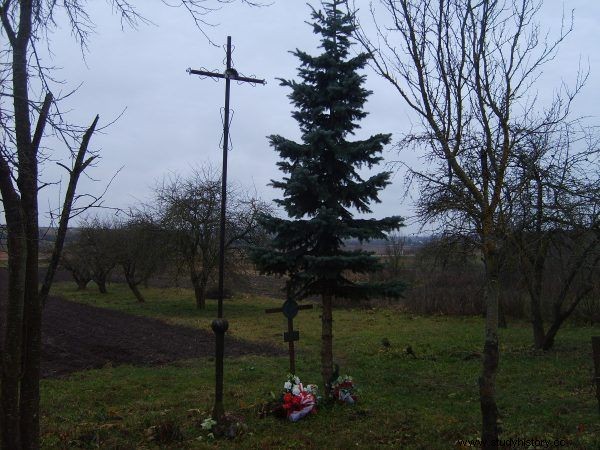
Kryże at the site of the Battle of Kodziowce (photo:Ministry of Foreign Affairs of the Republic of Poland, CC BY-ND 2.0).
Gen. Przeździecki states that in the area of Sopoćkiń 22 Soviet tanks were destroyed (including 17 near Kodziowce). This is confirmed by the rtm account. Łopianowski, who adds that his soldiers crashed 11 machines, and the remaining 6 were immobilized near the farm. According to chaotic Soviet documents, the enemy estimated his losses as 12 tanks and as many as 800 soldiers . The latter number is very skeptical by rtm. Łopianowski, who claims that it is overstated.
Towards Lithuania
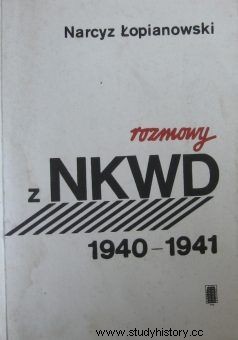
The article was based, inter alia, on on the memoirs of Narcyz Łopianowski, Fri. "Conversations with the NKVD 1940-1941" ("Pax" Publishing Institute 1991).
After the battle of Kodziowce, the 101st lancers broke through to Lithuania, where its soldiers were interned. Later they were taken captive by the Soviets. Ławrientij Beria himself was impressed by the achievement of the Polish lancers . He was particularly impressed by the attitude of the Captain. Łopianowski. This is what made him one of the 395 Polish officers who avoided the Katyn massacre. In 2007, TVP made a play based on his memories, entitled The Villa of Happiness.
The result of the clash at Kodziowce was determined by the disastrous Soviet command and the disregard for the Polish forces. However, the composure and improvisation shown by our commanders deserve respect. One should not forget about the heroic and sometimes even heroic attitude of the lancers.
It is worth mentioning here two names of ordinary soldiers:Cpl. Choroszczuka and ułana Połczanina, who jumped on tanks during the fights and with the butts of their handguns neutralized the cannons and machine guns . Rtm. Łopianowski described it with madly advanced courage.
